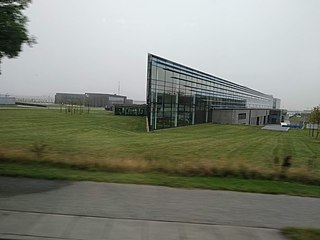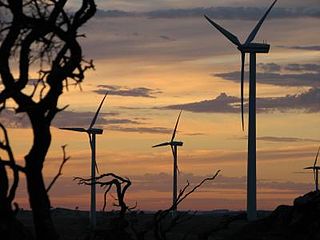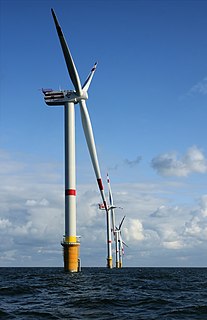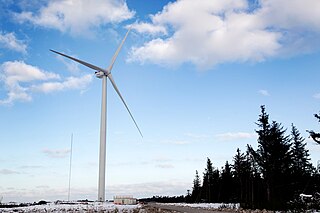
Vestas Wind Systems A/S is a Danish manufacturer, seller, installer, and servicer of wind turbines that was founded in 1945. The company operates manufacturing plants in Denmark, Germany, the Netherlands, Taiwan, India, Italy, Romania, the United Kingdom, Spain, Sweden, Norway, Australia, China, Brazil, Poland and the United States, and employs more than 25,000 people globally.

The Portland wind farm is one of Australia's largest wind farms. Located on the coast of south-western Victoria near the city of Portland, it consists of four separate sites, all of which have been completed as of 2015. Completion of the entire 195 MW project was expected in 2011, at a capital cost of A$330 million.
The Thanet Wind Farm is an offshore wind farm 7 miles (11 km) off the coast of Thanet district in Kent, England. On commissioning it was the world's largest offshore wind farm. It has a nameplate capacity of 300 MW and it cost £780–900 million (US$1.2–1.4 billion). Thanet is one of fifteen Round 2 wind projects announced by the Crown Estate in January 2004 but the first to be developed. It was officially opened on 23 September 2010, when it overtook Horns Rev 2 as the biggest offshore wind farm in the world. It has since been overtaken by many others.

Canunda Wind Farm is a $92.5 million, 46 MW wind power project located on grazing land approximately 16 kilometres south of Millicent, and 6 kilometres west of Tantanoola in South Australia. It is jointly owned by GDF Suez Energy AustraliaEn 72%) and Mitsui (28%).

Siemens Gamesa Renewable Energy S.A., formerly Gamesa Corporación Tecnológica S.A. and Grupo Auxiliar Metalúrgico S.A., is a Spanish-German wind engineering company based in Zamudio, Biscay, Spain. It manufactures wind turbines and provides onshore and offshore wind services. It is the world's second largest wind turbine manufacturer.

The Tararua Wind Farm is a wind farm owned and operated by Mercury NZ Ltd. It is located on 700ha of farmland on the Tararua Ranges of New Zealand. It has become New Zealand's largest capacity wind farm, with a total capacity of 161MW.

A floating wind turbine is an offshore wind turbine mounted on a floating structure that allows the turbine to generate electricity in water depths where fixed-foundation turbines are not feasible. Floating wind farms have the potential to significantly increase the sea area available for offshore wind farms, especially in countries with limited shallow waters, such as Japan, France and US West coast. Locating wind farms further offshore can also reduce visual pollution, provide better accommodation for fishing and shipping lanes, and reach stronger and more consistent winds.

The Barrow Offshore Wind Farm is a 30 turbine 90MW capacity offshore wind farm in the East Irish Sea approximately 7 kilometres (4.3 mi) south west of Walney Island, near Barrow-in-Furness, Cumbria, England.

The Burbo Bank Offshore Wind Farm is a 348 MW offshore wind farm located on the Burbo Flats in Liverpool Bay on the west coast of the UK in the Irish Sea. It consists of an original 90 MW wind farm commissioned in 2007 and a 258 MW extension completed in 2017.

Carno is a wind farm of 68 turbines which started operation in October 1996. It covers an area of over 600 hectares on Trannon Moor, a plateau to the west of the village of Carno in Powys, Mid Wales, 400 metres (1,300 ft) above sea level.
There are a number of wind power projects in the state of Maine, totaling more than 900 megawatts (MW) in capacity and responsible for 13.85% of in-state electricity production in 2017. In 2019, Maine had more wind capacity than the other five New England states combined, at 923 MW.

A wind turbine is a device that converts the kinetic energy of wind into electrical energy. Hundreds of thousands of large turbines, in installations known as wind farms, now generate over 650 gigawatts of power, with 60 GW added each year. Wind turbines are an increasingly important source of intermittent renewable energy, and are used in many countries to lower energy costs and reduce reliance on fossil fuels. One study claimed that, as of 2009, wind had the "lowest relative greenhouse gas emissions, the least water consumption demands and, the most favorable social impacts" compared to photovoltaic, hydro, geothermal, coal and gas energy sources.
As of June 2022, wind power in the Netherlands has an installed capacity of 8,052 MW, 30.5% of which is based offshore. In 2019, the wind turbines provided the country with 12% of its electricity demand during the year, a figure that is growing but somewhat below the average of 15% that wind power provides across the whole of the EU's electricity consumption. The Dutch are trying to meet the EU-set target of producing 14% of total energy use from renewable sources by 2020, and 16% by 2023. Windmills have historically played a major part in the Netherlands by providing an alternative to water driven mills.

Waterloo wind farm is east of Manoora, South Australia. It is the largest wind farm operated by EnergyAustralia.
Triton Knoll Wind Farm is an 857 MW round 2 offshore wind farm nearing completion 33 kilometres (21 mi) off the coast of Lincolnshire, in the North Sea, England.

The great majority of wind turbines around the world belong to individuals or corporations who use them to generate electric power or to perform mechanical work. As such, wind turbines are primarily designed to be working devices. However, the large size and height above surroundings of modern industrial wind turbines, combined with their moving rotors, often makes them among the most conspicuous objects in their areas. A few localities have exploited the attention-getting nature of wind turbines by placing them on public display, either with visitor centers on their bases, or with viewing areas farther away. The wind turbines themselves are generally of conventional horizontal-axis, three-bladed design, and generate power to feed electrical grids, but they also serve the unconventional roles of technology demonstration, public relations, and education.
Şamlı Wind Farm is an onshore wind power plant in Şamlı in Balıkesir Province in western Turkey.

The Vestas V164 is a three-bladed offshore wind turbine, produced by Vestas, with a nameplate capacity of up to 10 megawatts, a world record. Vestas revealed the V164's design in 2011 with the first prototype unit operated at Østerild in northern Denmark in January 2014. The first industrial units were installed in 2016 at Burbo Bank, off the west coast of the United Kingdom. By 2021, Vestas had produced 500 of the series.

Odense Harbour is the port of Odense, Denmark. Founded in 1803, Denmark's only canal harbour is the country's seventh largest commercial port in terms of turnover. It consists primarily of Inner Harbour, at the end of Odense Canal, and Odense Steel Terminal of Munkebo, which is located adjacent to the Odense Steel Shipyard. The port has a land area of approximately 4,000,000 square metres (43,000,000 sq ft) and a water area of almost 1,000,000 square metres (11,000,000 sq ft). Its industrial importance has declined since the 1960s, but a transformation is underway, including new residential and small business areas.
The Port Augusta Renewable Energy Park is a combined wind and solar farm under construction south of Port Augusta in South Australia, Australia. The solar farm is planned to be at the northern end of the site, west of the Augusta Highway and south of Sundrop Farms. The wind turbines will be on both sides of the Augusta Highway, extending south as far as the road to Horrocks Pass. Construction formally started in October 2020 and is estimated to take about 18 months to complete. The total site is about 5,400 hectares.













